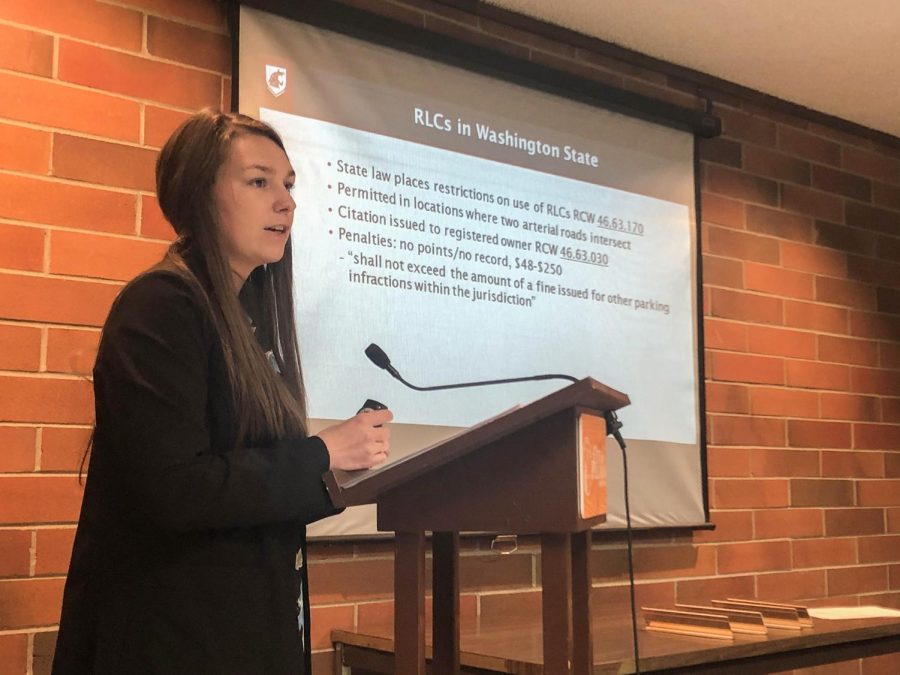New traffic safety methods may lessen road violations
Red-light cameras increase collisions, doctoral student says in research presentation
JAKOB THORINGTON | THE DAILY EVERGREEN
Megan Parks, WSU criminal justice and criminology doctoral student, presents research about the effectiveness of red-light cameras on Monday during a Pullman Police Advisory Committee in the City Hall Council Chambers.
February 11, 2020
Red-light cameras are designed and implemented by cities to reduce the amount of traffic violations and intersection collisions. However studies over the past decade show there are more effective methods to achieving this goal.
Megan Parks, WSU criminal justice and criminology doctoral student, presented data on the effectiveness of red-light cameras to the Pullman Police Advisory Committee during a meeting on Monday.
“Overall, the research on the effectiveness of red-light cameras has been a source of controversy over the research community,” Parks said.
Red-light cameras are cameras put on traffic lights which photograph traffic infractions at a red-light.
Parks is also a research fellow in the Public Safety Fellowship (PSF). The PSF was established by WSU associate professor of criminal justice David Makin.
The fellowship works with Pullman and Moscow law enforcement to research and collect data to help improve public safety and policing.
“That’s literally [Parks’s] job and my job is to teach her how to do these things so it works out,” Makin said.
Parks cited several research studies, including ones from 2005, 2015, 2017 and 2019 which showed a decrease in the average number of crashes at intersections. However, the studies found an increased number of rear-end crashes.
From 2008 to 2012, the use of red-light cameras in Spokane saw a 24 percent decrease in crashes per year and 53 percent decrease in red-light related crashes, Parks said. There was also a 51 percent decrease in T-bone crashes and a 41 percent increase in rear-end crashes.
“If you look at the raw numbers, they’re pretty small,” Parks said. “That’s pretty consistent with the other research as well.”
Pullman Chief of Police Gary Jenkins said the police department has no data about red-light crashes, but could obtain it.
“It would take some doing to collect that information, but that information is available,” Jenkins said.
She said there has been an increasing number of communities that are removing red-light cameras. Factors such as camera vendor revenue and the burden of proof to identify drivers have contributed to the removal of cameras, she said.
“When contractors receive a cut of the revenue, this is really problematic because it gives incentive to contractors to rig the system to increase the revenue,” Parks said. “It really undermines public safety because in these cases, they’re doing things like shortening the times of yellow lights.”
Alternative methods such as increasing yellow-light times, implementing a brief period where all lights at an intersection are red and increased traffic light visibility can be more effective than red-light cameras, Parks said.
She said cities must consider whether the goal of using red-light cameras is to reduce violations or reduce collisions.
“There is really a difference between taking a problem-solving approach to issues versus taking a more punitive response,” she said.
Jenkins said Pullman is not considering implementing red-light cameras in the city because there has not been a serious problem with red-light collisions.
“We do get asked about that regularly so it’s good information to have,” he said.
Makin said the fellowship focuses on data which will help smaller law enforcement agencies like Pullman PD because research in large cities is not applicable to small cities like Pullman or Moscow.
“We always almost focus on Seattle and NYPD,” he said. “[We’re] trying to get people to see the real value of this type of data because you can be much more nimble and responsive with a community this size.”
Most collisions that occur in Pullman are due to weather and road conditions, Jenkins said.
The committee also decided to introduce new police officers during the next meeting on March 9.












